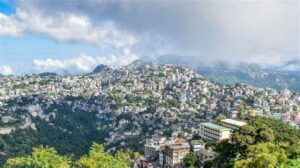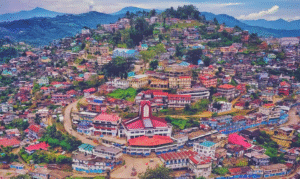Introduction
Perched at an altitude of about 1,465 meters (4,806 feet), Reiek Tlang is one of Mizoram’s most iconic peaks. Located roughly 29 kilometers from Aizawl, the capital city, this mountain is more than just a visual marvel. It offers stunning panoramic views of the surrounding valleys and hills, harbors rich biodiversity, and holds cultural significance among the Mizo people.
This academic blog explores Reiek Tlang from a multidisciplinary perspective—geography, ecology, anthropology, and sustainable tourism—highlighting its significance in Mizoram’s environmental and cultural landscape.
Geographic Profile
Geomorphological Context
Reiek Tlang is part of the Lushai Hills range, a sub-system of the Patkai range in Northeast India. These hills were formed during the Neogene period of the Cenozoic era due to the convergence of the Indian and Burmese tectonic plates. The region is characterized by folded and faulted rock formations, steep slopes, and a high rate of erosion due to intense monsoons.
The summit of Reiek Tlang offers a unique vantage point, often above the cloud line, giving it a dramatic and otherworldly appeal. On clear days, one can see the plains of Bangladesh and the surrounding forested mountains that define Mizoram’s topography.
Ecological Significance
Flora and Fauna
The area around Reiek Tlang is dominated by sub-tropical broadleaf forests. Common trees include various species of oaks, chestnuts, and bamboos. The undergrowth is rich with ferns, orchids, and wildflowers, especially in the post-monsoon season.
Bird watchers and ecologists find Reiek an important site for spotting species like:
- The Mrs. Hume’s pheasant (Syrmaticus humiae), Mizoram’s state bird
- Great hornbills
- Hill mynas
- Various endemic butterflies and moths
This biodiversity underscores the mountain’s role as a micro-habitat, essential for ecological studies and conservation efforts.
Cultural Importance
Myths and Legends
According to Mizo folklore, Reiek Tlang was once a stronghold of a powerful chieftain. Legends tell of supernatural beings and brave warriors who once dwelled in the area. The mountain’s sacred status is linked to these stories, making it more than just a geological feature—it is a spiritual symbol of ancestral memory.
Reiek Heritage Village
At the base of the mountain lies the Reiek Heritage Village, developed by the Mizoram Tourism Department to preserve and showcase traditional Mizo lifestyle. The village includes replicas of traditional Mizo huts of different tribes like the Lusei, Hmar, and Paihte, alongside chieftain houses and granaries. It plays a key role in cultural education for both locals and tourists.
Anthropological Significance
Living Traditions
Reiek is also a venue for important community festivals. The Anthurium Festival, organized annually in September, celebrates the locally grown flower and showcases Mizo music, dance, handicrafts, and cuisine. The mountain becomes a living space of cultural performance, drawing thousands of visitors and cultural researchers.
This interplay of landscape and tradition makes Reiek an anthropological resource, offering insights into indigenous knowledge systems, settlement patterns, and identity narratives of the Mizo people.
Tourism and Accessibility
Infrastructure
Reiek is among the few eco-tourism destinations in Mizoram with well-developed infrastructure:
- Motorable roads connect it to Aizawl.
- A tourist lodge managed by the Department of Tourism offers lodging facilities.
- Guided trekking trails and a designated viewpoint are present.
- Eco-tourism booths and cultural exhibition centers enhance the visitor experience.
The accessibility and facilities make Reiek suitable for educational tours, biodiversity studies, and leisure travel.
Responsible Tourism
With increasing footfall, the focus has shifted toward eco-friendly tourism. Signboards encourage waste segregation and minimal plastic use. Local guides are trained to promote sustainable practices and cultural sensitivity.
The challenge lies in scaling tourism while preserving the site’s fragile ecology and cultural authenticity.
Climate and Best Time to Visit
Reiek enjoys a subtropical highland climate. Temperatures range from 10°C to 25°C across the year. The best time to visit is during:
- Post-monsoon (October to February) – Clear skies and cool weather offer optimal viewing.
- Anthurium Festival (September) – A peak period for cultural immersion.
Monsoons (June to September) make the trails slippery and risky but turn the forests lush and vibrant, attracting a niche group of nature lovers.
Academic and Educational Utility
Geography and Geology
Students of earth sciences benefit from studying the rock layers, erosion patterns, and sedimentation visible on the mountain’s trails. The Lushai Hills are textbook examples of tectonic uplift and weathering processes in high rainfall zones.
Ecology and Biodiversity
Botany and zoology students can catalog the varied plant life, study forest canopy dynamics, and conduct species inventory—especially during the flowering season when pollinators are abundant.
Anthropology and History
The Heritage Village and associated festivals offer anthropologists and sociologists a platform to study:
- Kinship and chieftain systems
- Traditional architectural styles
- Oral traditions and their relationship to space
Challenges and Conservation
Environmental Concerns
Increased tourism has led to:
- Littering and pollution
- Trail degradation due to excessive footfall
- Noise disturbance affecting local fauna
There is a pressing need for:
- Stringent regulations on waste management
- Rotational closure of trails for habitat recovery
- Cap on daily visitors during peak seasons
Cultural Erosion
While Reiek Heritage Village preserves tradition, there’s also concern that commercial performances may dilute authentic practices. To avoid this, partnerships with local elders and scholars are being encouraged to ensure accuracy and cultural respect.
Policy and Community Involvement
The Mizoram State Tourism Policy emphasizes community participation in managing eco-tourism destinations like Reiek. Local villagers are employed as guides, cooks, and caretakers. Revenue from tourism is partially reinvested into community development and conservation activities.
Collaborations between NGOs, government bodies, and academic institutions are key to ensuring that Reiek remains both an educational hub and a living cultural archive.
Future Prospects
Proposed Developments
Plans under consideration include:
- A small eco-interpretation center
- Solar-powered lighting for trails
- Online booking systems for crowd management
- Incentives for research-based tourism and student tours
These initiatives aim to transform Reiek into a holistic learning environment without compromising its ecological or cultural integrity.
Conclusion
Reiek Tlang is not just a mountain. It is a living classroom, a cultural repository, and a model for sustainable tourism in Northeast India. Its panoramic vistas may draw the traveler, but its deeper value lies in what it teaches us about harmony—between people and nature, tradition and modernity, tourism and conservation.
Preserving Reiek’s essence demands a balanced approach that integrates academic inquiry, environmental ethics, and cultural continuity. Whether you’re a geographer, ecologist, student, or storyteller, Reiek has something to offer—if you pause long enough to listen to the wind rustle through its ancient trees.






